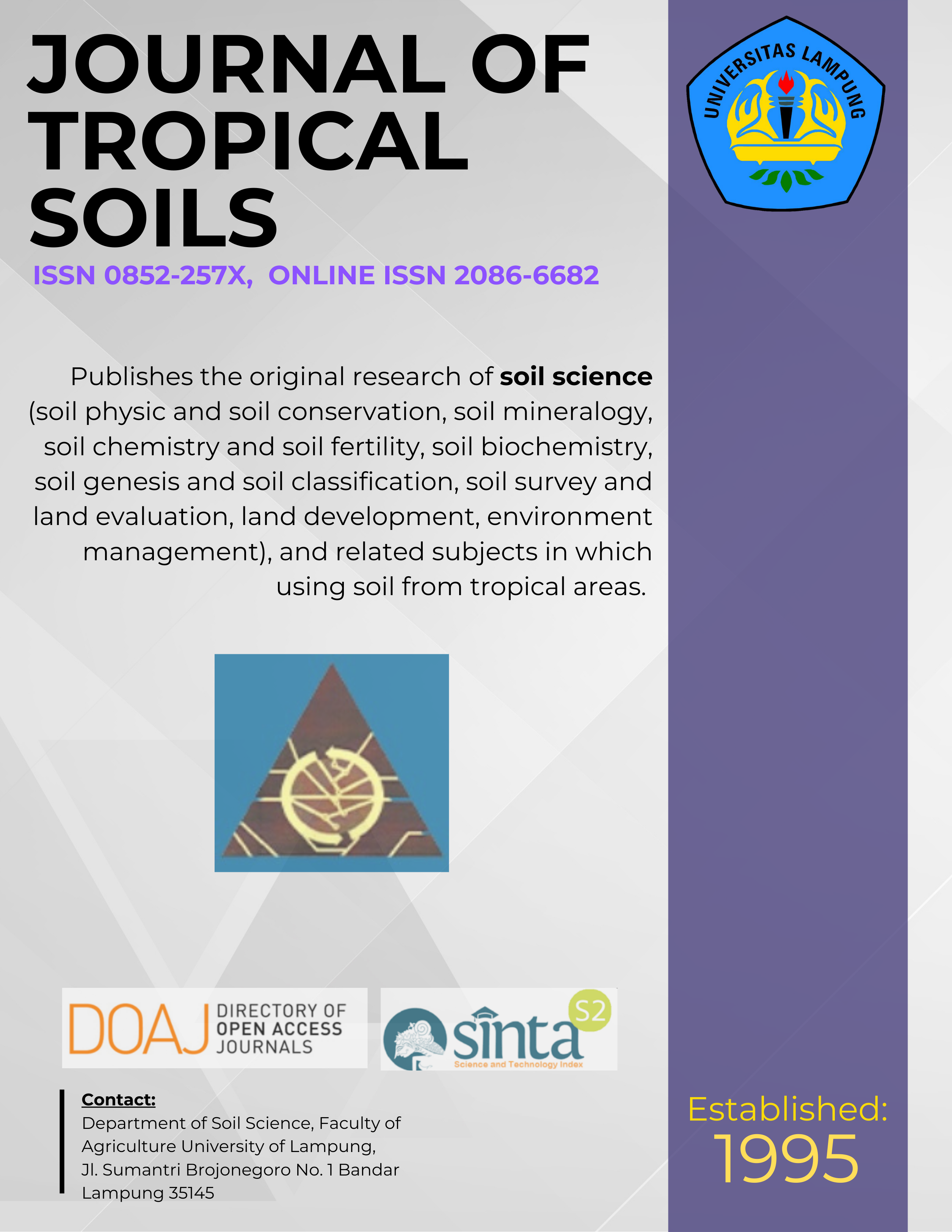Changes in Soil Available Phosphorus, Leaf Phosphorus Content and Yield of Sword Bean (Canavalia ensiformis (L.) DC.) by Application of SP-36 and Phosphate Rock on Acid Upland Soil of East Lampung
Main Article Content
Abstract
A glasshouse trial was performed to determine changes in phosphorus (P) nutrition and the yield of sword bean (Canavalia ensiformis (L.) DC.) following the application of different rates and types of P fertilizer in an acid upland soil of East Lampung. Two different types of P fertilizer, namely SP-36 (total P = 36%) and Phosphate Rock (PR) (total P = 24.3%, particle size distribution = 75% <0.25 mm, 85% < 0.50 mm, 90% < 1.00 mm) were used in the trial. For the treatment, each P fertilizer type consisted of four rates (0, 50, 100 and 150 mg P2O5 kg-1 soil) that were arranged in a Completely Randomized Design with four replications. The results showed that the application of P fertilizers had significant effects on soil pH, soil plant-available P, the potential-P (HCl 25%), leaf N and P concentrations, the yield of sword bean. Increased rates of both forms of P fertilizer increased the soil pH values. As the soil used had low pH and very high exchangeable Al, hence, this result is most probably related to the addition of Ca2+ to the soil solution that resulted from the P fertiliser applied (liming effect), either from SP-36 (monocalcium phosphate) or PR (flour apatite). There was no difference in soil available P concentration due to the different in P fertilizer types, indicating that 4 months after the fertilizer application, the relatively insoluble Phosphate Rock had the same P solubility with SP-36. Increased rates of both forms of P fertilizer increased the sword bean yield. For the application of 0 kg P2O5 ha-1, although sword bean crops had pods, but, they did not give any seed. Whereas, at the addition of P fertilizer at the rate of 50, 100, and 150 kg P2O5 ha-1 for both P fertilizer types, the crops were able to give the seeds in the pods.
[How to Cite: Achmad AR. 2015. Changes in Soil Available Phosphorus, Leaf Phosphorus Content and Yield of Sword Bean (Canavalia ensiformis (L.) DC.) by Application of SP-36 and Phosphate Rock on Acid Upland Soil of East Lampung. J Trop Soils 19: 29-36. Doi: 10.5400/jts.2015.20.1.29]
[Permalink/DOI: www.dx.doi.org/10.5400/jts.2015.20.1.29]
Downloads
Article Details
Section
License for Authors
Authors who publish with this journal agree to the following terms:
- Authors retain copyright and grant the journal right of first publication with the work simultaneously licensed under a Creative Commons Attribution License that allows others to share the work with an acknowledgement of the work's authorship and initial publication in this journal.
- Authors are able to enter into separate, additional contractual arrangements for the non-exclusive distribution of the journal's published version of the work (e.g., post it to an institutional repository or publish it in a book), with an acknowledgement of its initial publication in this journal.
- Authors are permitted and encouraged to post their work online (e.g., in institutional repositories or on their website) prior to and during the submission process, as it can lead to productive exchanges, as well as earlier and greater citation of published work (See The Effect of Open Access).
License for Regular Users
Other regular users who want to cite, distribute, remix, tweak, and build upon author’s works, even for commercial purposes, should acknowledge the work’s authorship and initial publication in this journal, licensed under a Creative Commons Attribution License.

